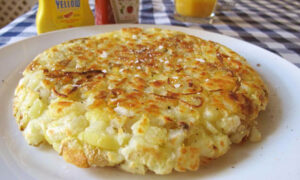If a potato has any place at all on the breakfast table, surely it must be in the form of butter-golden, crispy yet fluffy, hot hash browns.
 Felicity’s perfect hash brown. Photograph: Felicity Cloake
Felicity’s perfect hash brown. Photograph: Felicity CloakeI’ve spent the last fortnight in the United States. Yellow grits, blueberry pancakes, biscuits and gravy – I managed to tick off most of thebreakfast items in the I-Spy book of American cliches, but to my disappointment, not a single one came with hash browns. I’d hoped to return home an expert, but my principal experience of hash browns remains the crunchy orange triangles traditionally served with spaghetti hoops at school. These, however, were certainly preferable to the greasy, floppy rosti-like creations I ate in Chicago a few years ago – and neither, I’d hope, are representative of the true glory of the hash brown.
I lugged three large American cookbooks back in my suitcase, but only one had a recipe for hash browns, and that, in the 75th anniversary edition of the classic Joy of Cooking, sounded remarkably like a rosti. Panicked, I wondered whether they were in fact different names for the same dish, but the Oxford Companion to Food reassured me that hash browns are “small rissole-like cakes of cooked and finely chopped potato” in the fine tradition of American hashes rather than the cakes cooked from raw or parboiled potato favoured in Switzerland.
Hashes, the American equivalent of British bubble and squeak, have always been a favourite way of using up motley leftovers, so this makes sense. Hash, of course, comes from the French verb hacher, to chop up, which suggests the spuds should be cut up and, of course, browned rather than just heated through. But apart from these clues, I’m going into this challenge somewhat blind. According to the various recipes, hash browns can be anything from a loose collection of crunchy fried potato chunks, often labelled as “breakfast potatoes” on the menus I came across, to crunchy, latke-like potato pancakes – but which fits the breakfast bill best?
The spuds

I find the waxy varieties keep their shape too well after grating, making the finished hash brown much like a rosti, with each individual strand distinct from every other. The floury potatoes, meanwhile, mould into each other, creating a hash brown that’s crunchy on the outside and slightly fluffy within. Much better, in my opinion, for pairing with eggs, sunny-side up or not.
Precooked or nay?

The older recipes don’t specify how the potato is to be cooked, presumably because they’re designed to use up leftovers, but Slater and Davis boil theirs to tenderness (“until you can poke a bamboo skewer through a potato” the latter explains), and Moulton bakes hers. If you have leftover jacket potatoes don’t shy away from using them as the flavour is delicious, but you do lose quite a lot of potato with the skins so if you’re cooking spuds specifically to make hash browns boiling is less wasteful of food and energy.
Both Davis and Moulton allow the potato to cool and dry out before use; an improvement on Slater’s version, which adds it straight to the pan, making his hash brown slightly damp.
The cut

The grated potato is rather too reminiscent of a rosti for my liking (as well as proving difficult with the floury variety I’ve chosen to use) but the big chunks are too much like ordinary home fries: a hash brown should surely be a cake of potato, rather than a few hulking bits scattered across the plate. Finely chopping the spuds, as seems to be traditional, allows them to crisp up nicely on the outside like the grated potato, while staying soft inside like the potato chunks. Pressing the bits down into the pan “with the palm of your hand”, as Day Reese suggests, helps to bring them together into a coherent mass.
None of the older recipes make any mention of skin, and of the others, only Nigella recommends keeping it on. Unless you’re dealing with thick-skinned knobbly monsters or have leftover peeled potatoes to use up, I’d leave it on. It adds extra flavour to the dish and goes wonderfully crisp when it comes into contact with the pan.
Chewing the fat

Into the frying pan

Additions

Nigella adds cayenne pepper, which I’m not so keen on here – the hash brown should be a rock of buttery calm on the breakfast plate – and the Joy of Cooking and Day Reese both include parsley. It brings colour to the dish, but I don’t think it adds anything to the flavour.

Do season the potatoes before adding them to the pan though, as Davis suggests: hash browns have a tendency to be bland and this works better than seasoning the finished dish.
Perfect hash browns

Serves 2-3
500g floury potatoes, scrubbed and cut into large chunks
35g butter or 25g bacon drippings
½ onion, thinly sliced
1. Put the potatoes in a large pan of cold, salted water and bring to the boil. Simmer until tender, then drain well and set aside to cool and dry out completely.
2. If using butter, clarify it by putting it in a small pan over a medium heat and skimming off the foam that rises to the top. When it stops bubbling, pour it through a fine sieve or cheesecloth to strain off any solids, then set aside until ready to use.
3. Heat a small heavy-based frying pan on a medium heat, and add half the butter or dripping. Cook the onion until soft and golden. Meanwhile, finely chop the cooked and cooled potatoes and season well.
4. Turn up the heat to medium-high and add the potatoes to the pan in one layer, stirring to incorporate the onions. Push down to make a cake, then cook for about 15 minutes until crisp and well browned on the bottom, then tip on to a plate and add the rest of the butter or dripping to the pan. Slide the hash brown back into the pan, browned side up, and cook for about another 10 minutes, then cut in half and serve.
Are hash browns the best kind of breakfast potato, or do you prefer tattie scones or country fries – indeed, does a potato have any place on the breakfast table at all? Do you yearn for the crunchy, orange cafeteria variety, and if so, does anyone have any suggestions about how to recreate those guilty pleasures from scratch?
(The Guardian)















